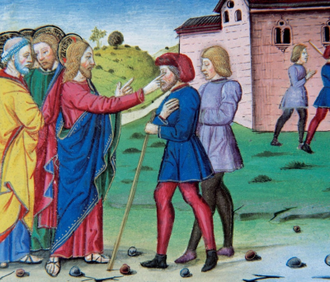Gospel in Art: Two blind men followed Jesus

Jesus healing two blind men, Cristoforo de Predis,1476 © Royal Library, Turin
Source: Christian Art
Gospel of 6 December 2024
Matthew 9:27-31
At that time: As Jesus passed on from Capernaum, two blind men followed him, crying aloud, 'Have mercy on us, Son of David.' When he entered the house, the blind men came to him, and Jesus said to them, 'Do you believe that I am able to do this?' They said to him, 'Yes, Lord.' Then he touched their eyes, saying, 'According to your faith be it done to you.' And their eyes were opened. And Jesus sternly warned them, 'See that no one knows about it.' But they went away and spread his fame through all that district.
Reflection on the Illuminated Manuscript Page
I am struck by the opening of today's Gospel reading, which recounts how 'two blind men followed Jesus, shouting, "Have pity on us, Son of David."' It raises an intriguing question: if they were blind, how were they able to follow Jesus? It seems that, while their physical eyes were closed, their spiritual vision was wide open. They saw with a depth of faith that eluded many whose physical sight was flawless. Likely, they followed the sound of Jesus' voice, letting it guide them through the crowd. Their faith enabled them to perceive what others could not.
When Jesus asked them, 'Do you believe I can do this?' they responded immediately, 'Yes Lord.' Their unwavering faith allowed them to recognise the Lord's goodness before their physical eyes were opened. The Psalmist today proclaims, 'I am sure I shall see the Lord's goodness in the land of the living.' These blind men saw that goodness in Jesus long before their healing. We, too, are called to develop this deeper vision, to see with the eyes of faith. Signs of the Lord's goodness surround us, but we need open hearts and attentive spirits to recognise them.
Our illustration is drawn from the Codex of Predis (1476), a remarkable illuminated manuscript featuring exquisite miniature paintings by Cristoforo de Predis. Commissioned by the powerful Sforza family, the ruling dynasty of Milan during the Renaissance, the codex is a testament to the era's fusion of art, faith, and political ambition. The Codex of Predis is renowned for its depictions of biblical narratives and genealogies. Its illustrations vividly recount key stories from the Bible while tracing genealogical links between biblical figures and later generations. These genealogies served to align sacred history with contemporary rulers, subtly reinforcing the Sforzas' claim to divine authority. Cristoforo de Predis, a talented court painter and illuminator, brought these scenes to life with meticulous attention to detail and a refined sense of composition. Born deaf, Cristoforo's unique perception of the world influenced his artistic style, resulting in works celebrated for their delicacy.
LINKS
Gospel in Art: https://christian.art/
Today's Reflection: https://christian.art/daily-gospel-reading/matthew-9-27-31-2024/


















